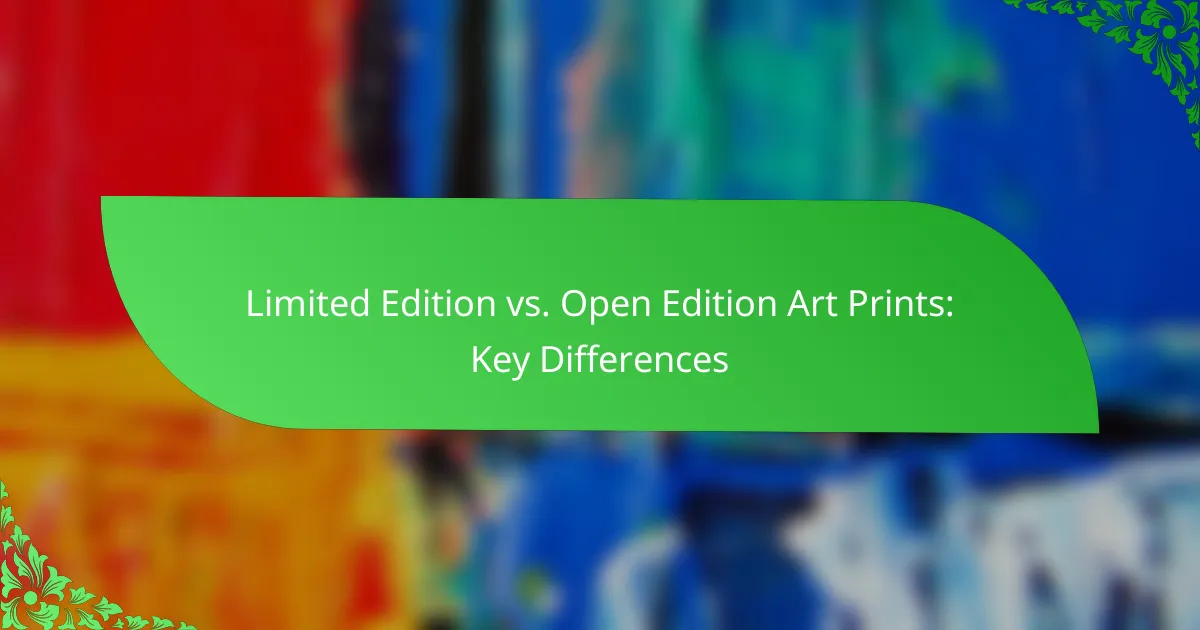When it comes to art prints, understanding the difference between Limited Edition and Open Edition is crucial for collectors and buyers alike. Limited Edition prints are produced in a finite number, enhancing their value and exclusivity, while Open Edition prints can be reproduced indefinitely, making them more accessible. This distinction not only affects pricing but also influences the desirability and market dynamics of the artwork.

What are the key differences between Limited Edition and Open Edition Art Prints?
Limited Edition art prints have a specific number of copies produced, while Open Edition prints can be printed indefinitely. This distinction impacts their value, collectibility, and appeal to buyers.
Limited Edition prints have a fixed number of copies
Limited Edition prints are produced in a predetermined quantity, often ranging from a few dozen to a few hundred. Each print is typically numbered, such as 1/100, indicating its place in the series. This fixed number creates scarcity, which can enhance the print’s desirability.
Artists often sign and sometimes include a certificate of authenticity with Limited Edition prints, further establishing their value. Buyers should verify the edition size and the artist’s reputation to assess potential future value.
Open Edition prints have no production limits
Open Edition prints are produced without any restrictions on the number of copies. This means that as long as there is demand, the artist or publisher can continue to print more. These prints are often more affordable due to their availability.
Since Open Edition prints do not have a limited supply, they generally lack the same level of exclusivity as Limited Edition prints. Buyers looking for budget-friendly options may prefer Open Editions, but they should be aware that these prints may not appreciate in value over time.
Value appreciation varies between editions
Limited Edition prints often appreciate in value due to their scarcity and the artist’s reputation. As the number of available prints decreases, demand can drive prices higher, making them a potential investment. Some Limited Edition prints can see value increases of several times their original price.
In contrast, Open Edition prints typically do not appreciate significantly. Their abundance means that prices remain stable or may even decrease over time. Buyers should consider their goals—whether for personal enjoyment or investment—when choosing between the two types.
Collectibility factors differ significantly
Collectibility is a key factor distinguishing Limited Edition from Open Edition prints. Limited Edition prints are often sought after by collectors, who value the exclusivity and potential for appreciation. Collectors may focus on the artist’s history, the edition size, and the print’s condition.
Open Edition prints, while popular for casual buyers, generally attract less interest from serious collectors. They may serve as decorative pieces rather than investment opportunities. Buyers should assess their collecting goals and preferences when deciding which type of print to pursue.
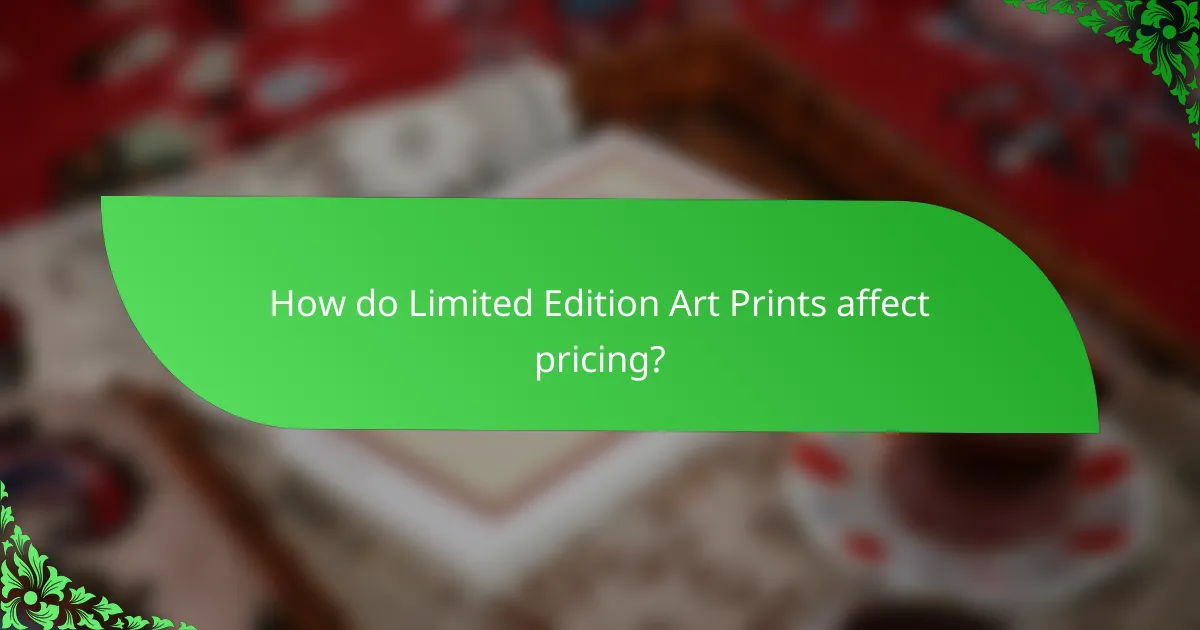
How do Limited Edition Art Prints affect pricing?
Limited edition art prints typically command higher prices than open editions due to their scarcity and perceived exclusivity. Collectors often value these prints more, leading to increased demand and higher market prices.
Higher prices due to scarcity and exclusivity
The limited nature of these prints means that only a specific number are produced, often signed and numbered by the artist. This scarcity creates a sense of exclusivity, which can drive prices significantly higher than open edition prints, sometimes by 50% or more.
For example, a limited edition print might sell for several hundred to thousands of dollars, while an open edition of the same artwork could be priced in the low hundreds. The unique appeal of owning a piece that few others have can justify the premium for many buyers.
Market demand influences pricing trends
Pricing for limited edition prints is heavily influenced by market demand. If an artist gains popularity or if a particular style becomes trendy, the value of their limited editions can rise sharply. Conversely, if interest wanes, prices may stabilize or even drop.
Collectors should monitor market trends and artist reputations to make informed purchasing decisions. Engaging with art communities and following auction results can provide insights into current pricing dynamics and help identify potential investment opportunities.

What are the benefits of purchasing Limited Edition Art Prints?
Purchasing limited edition art prints offers exclusivity and potential value appreciation. These prints are produced in small quantities, making them more desirable to collectors and art enthusiasts.
Investment potential for collectors
Limited edition art prints can serve as a solid investment for collectors. As the number of available prints decreases, their value may increase over time, especially if the artist gains recognition. Collectors often look for prints that are signed and numbered, as these features can enhance their market value.
When considering investment potential, it’s crucial to research the artist’s background and market trends. Established artists typically yield higher returns, while emerging artists may offer more risk but also greater rewards.
Unique artistic value and provenance
Limited edition art prints carry unique artistic value due to their scarcity and the artist’s involvement in the production process. Each print is often accompanied by a certificate of authenticity, which establishes its provenance and reinforces its value.
Collectors appreciate the story behind each piece, including the artist’s intent and the context of the edition. This connection can enhance the emotional and aesthetic appeal of the artwork, making it a more meaningful addition to any collection.
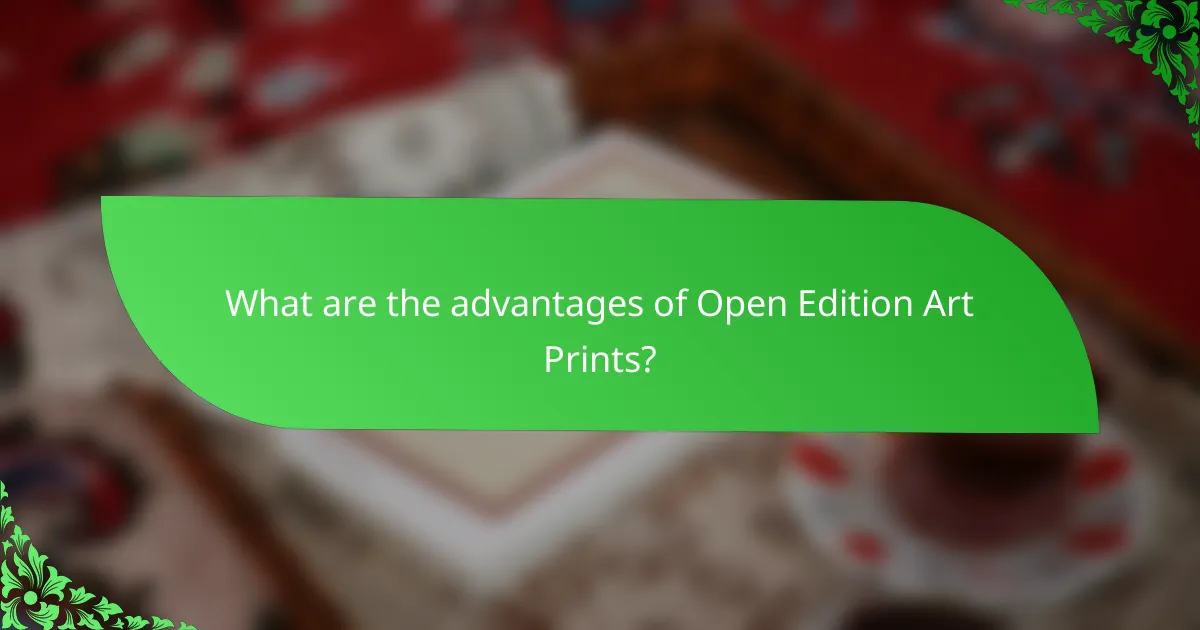
What are the advantages of Open Edition Art Prints?
Open edition art prints offer several advantages, primarily their affordability and accessibility. Unlike limited editions, which are often priced higher due to their scarcity, open editions allow more people to enjoy art without breaking the bank.
Affordability for a wider audience
Open edition prints are generally more budget-friendly, making them accessible to a larger audience. Prices can range from a few dozen to a couple of hundred dollars, depending on the artist and the print quality. This affordability allows art enthusiasts to purchase multiple pieces or gift art to friends and family without significant financial strain.
Additionally, the lower price point encourages new collectors to start their journey in the art world. By investing in open edition prints, individuals can explore different styles and artists without committing to high-cost limited editions.
Accessibility to popular artworks
Open edition prints often feature popular artworks that appeal to a broad audience. This means that iconic pieces or trendy designs are readily available, allowing collectors to acquire works that resonate with them. Many artists and galleries produce open editions to meet demand for their most sought-after pieces.
Furthermore, the availability of these prints online has increased significantly, enabling buyers to easily find and purchase art from various platforms. This convenience ensures that anyone can access and enjoy art that reflects their personal taste, regardless of their location.
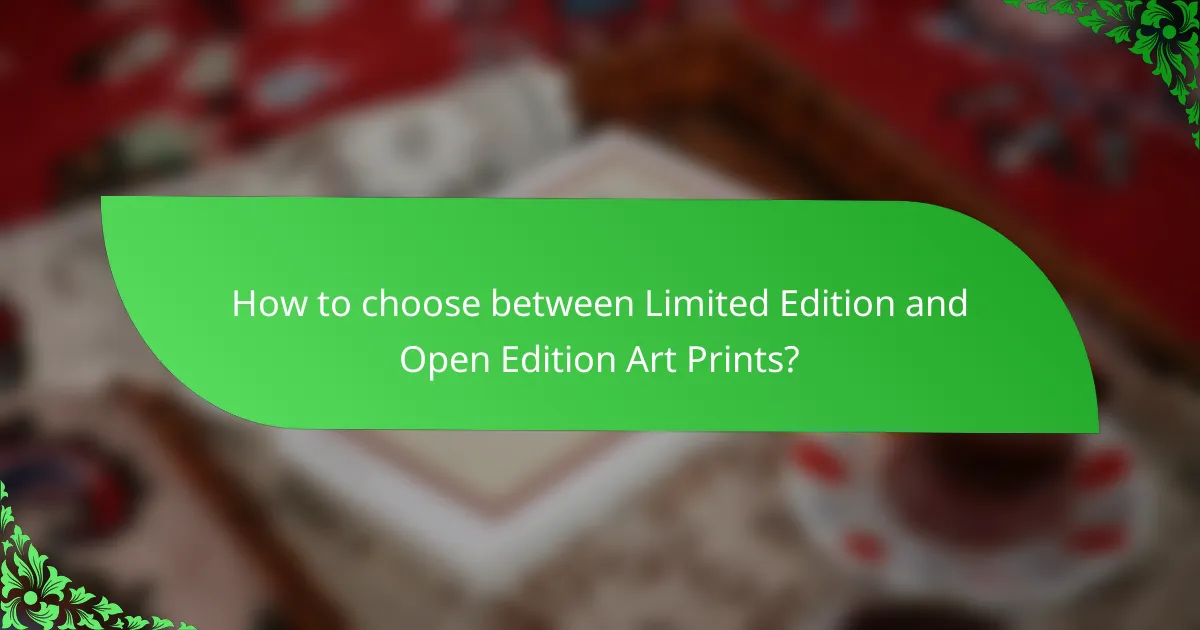
How to choose between Limited Edition and Open Edition Art Prints?
Choosing between limited edition and open edition art prints depends on your budget, investment goals, and personal taste. Limited editions often hold more value over time, while open editions provide more accessibility and variety.
Consider your budget and investment goals
When evaluating your budget, limited edition prints typically range from moderate to high prices, reflecting their exclusivity and potential for appreciation. Open edition prints are generally more affordable, making them suitable for those looking to decorate without a significant financial commitment.
If your goal is to invest in art, limited editions may offer better long-term value due to their scarcity. However, if you prioritize enjoyment and personal expression over investment, open editions can be a practical choice.
Evaluate personal taste and decor needs
Your personal taste plays a crucial role in deciding between limited and open edition prints. Limited editions often feature unique styles or themes that resonate with collectors, while open editions provide a broader selection, allowing for diverse decor options.
Consider how the artwork will fit into your space. Limited editions may serve as focal points in a room, while open editions can complement existing decor or fill larger areas without overwhelming your budget. Assessing your decor needs will help you choose prints that enhance your environment.

What are the best platforms for buying Limited and Open Edition Art Prints?
Some of the best platforms for purchasing limited and open edition art prints include Saatchi Art and Artfinder. Each platform offers unique selections and caters to different types of art collectors, making it essential to understand their features before making a purchase.
Saatchi Art for diverse selections
Saatchi Art is renowned for its extensive range of art prints, including both limited and open editions. The platform features works from artists around the globe, allowing buyers to explore various styles and mediums.
When shopping on Saatchi Art, consider filtering your search by edition type, size, and price range to find the perfect piece. Prices can vary widely, often starting from a few hundred dollars for limited editions to more affordable options for open editions.
Artfinder for independent artists
Artfinder focuses on connecting buyers with independent artists, offering a more personal touch in the art-buying experience. This platform emphasizes unique, handmade works, including limited and open edition prints.
When using Artfinder, look for artist profiles to learn more about their background and creative process. Prices for limited edition prints typically range from moderate to high, reflecting the artist’s reputation and the exclusivity of the work.
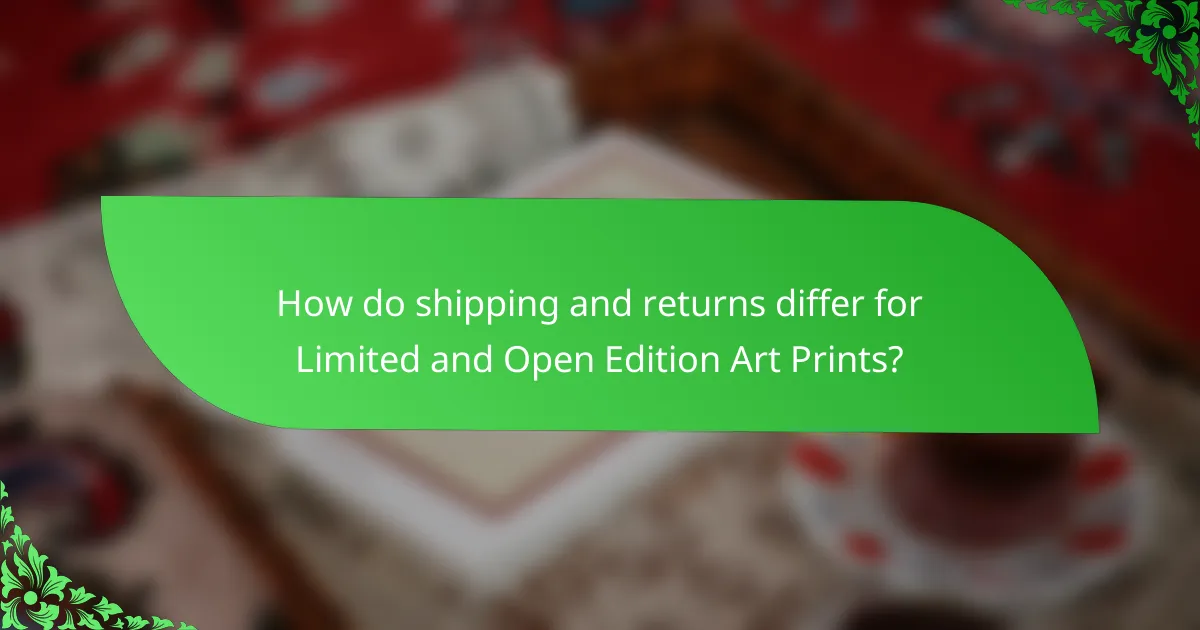
How do shipping and returns differ for Limited and Open Edition Art Prints?
Shipping and return policies for Limited and Open Edition Art Prints vary significantly. Limited Edition prints often come with stricter return policies due to their collectible nature, while Open Edition prints typically offer more flexible return options.
Limited Edition prints may have stricter return policies
Limited Edition prints are often considered investments, which leads to more stringent return policies. Many sellers may only accept returns if the item is defective or damaged upon arrival. This means buyers should carefully inspect their prints immediately upon receipt.
Additionally, some galleries or artists may require that the print remains in its original packaging to qualify for a return. It’s advisable to review the specific return policy before purchasing to avoid any surprises.
Open Edition prints often have more flexible returns
Open Edition prints generally come with more lenient return policies, allowing customers to return items for a broader range of reasons. Many retailers offer a satisfaction guarantee, enabling buyers to return prints within a specified timeframe, often around 30 days.
These flexible policies make Open Edition prints a safer choice for those who may be unsure about their purchase. However, it is still essential to check the individual seller’s return policy, as terms can vary widely.
